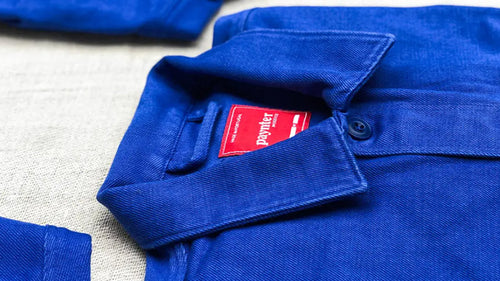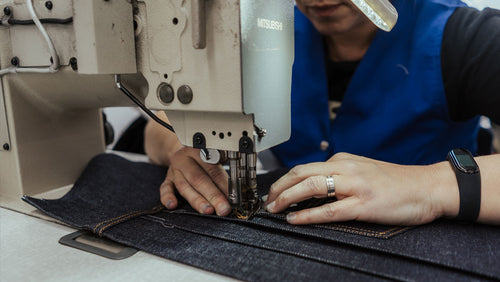
Perfectionism requires great dissatisfaction, and the story of Japanese denim begins in the 1980s, when obsessives realized something was lacking in American jeans.
Japan underwent a “jeans revolution” in the mid-Seventies. Denim trousers — limited in the Sixties to cowboy-wannabees and Trotskyite student radicals — quickly became ubiquitous among all teenagers. Kids first snapped up low-priced pairs from homegrown labels Big John, Edwin, and Bobson, and then moved on to the pioneering American brands Levi’s, Lee, and Wrangler. The most discerning consumers, however, were frustrated with their foreign bounty. In 1975, everyone picked up the magazine-catalog Made in U.S.A., which featured a pair of Levi’s 501s with the perfect fade on the cover. But their new pairs of 501s never could achieve the same patina.

No one quite knew why American denim failed to live up to their expectations, but they weren’t imagining things. To keep up with the exploding global demand for jeans during the 1970s, American manufacturers adopted quicker and cheaper production methods. For yarns, they replaced high-quality ring spinning with sloppier open-end spinning, which changed how the cotton twill absorbed the dye. And to increase the supply of fabric, they moved to larger industrial-grade looms. All of this cost-cutting resulted in a lackluster fade.
Most people around the world would not have noticed such changes, let alone pledged to do anything about it. But a few Japanese innovators channeled their disappointment into an intervention — one that would change jeans culture forever. Independent brands, in coordination with local spinning companies, weavers, and dyers, worked to create new, higher-quality artisanal denim that resurrected the feel of 1950s jeans. As an antidote to the industrial consistency of bland mass market yarns, the technical wizards in Japanese spinning companies invented a computerized method to re-introduce “slubby” inconsistencies. Meanwhile smaller factories pulled their vintage Toyoda selvedge sail cloth looms out of storage and wove the new slubby yarns into small-batch denim.
Independent brands used the resulting denim to sew together faithful reproductions of vintage American jeans, complete with leather patches and selvedge on the cuff. At first, the resulting pairs delighted Japanese consumers, by the early 21st century, they set the global standards for premium denim. Shockingly, it became conventional wisdom that Japanese companies created the most authentic denim, despite jeans long being perhaps the most potent symbol of the United States. Americans may have given birth to indigo-dyed denim, but it was the Japanese who achieved perfection.

Japanese perfectionism in the world of denim is hardly an isolated case. We see similar stories of high-quality production across a huge variety of fields: cars, sneakers, whiskey, coffee, Neapolitan pizza. In fact, the idea of Japanese manufacturing supremacy has almost become a cliché: What other countries invent, Japan perfects. The obvious question is, why? The story of denim is particularly odd: For whatever indigo traditions existed in Japan, there was no heritage of creating five-pocket trousers from 14 oz., indigo-dyed cotton twill, fastened with rivets. The Japanese government may have invested in textile mills after World War II, but these machines had to be retooled to spin the heavy yarns required for denim. And to achieve proper fades, Japanese companies had to unlearn traditional vat dyeing techniques and take up shallower American industrial rope dyeing. The first Japanese denim only appeared in 1973, made on giant Swiss Sulzer looms, and even at that time, the idea that Japan would come to produce the world’s best denim would have seemed far-fetched. And yet, with denim and dozens of other foreignborn products, Japanese perfectionism now sets the global standards.
At the same time, we must be careful not to avoid stereotypical and romantic explanations that posit a unique Japanese national spirit that guides the behavior of all citizens towards perfectionism. Japanese companies don’t make the best version of everything; few boast about Japanese wine, cheese, sausage, ham, detergent, pasta, blenders, or high heels. Instead, we should seek to explain why a specific set of Japanese organizations — artisans, brands, manufacturers — have pursued and maintained a perfectionist ethos in certain fields. Yes, cultural factors play a role here, but there are critical economic and historical factors that explain why that ethos was channeled into the creation of particular foreign products.

We should begin by examining the cultural factors that elevate a perfectionist ethos to an important collective ideal. Ancient philosophies don’t lead us to contemporary outcomes, but they do explain what actions come to receive esteem from others. In this case, perfectionism finds support in at least three virtues of Confucianism, the Chinese philosophy that long set the formal ethical underpinnings of Japanese civilization.
The first virtue is detail-orientation. Confucianism emphasizes praxis over belief — in particular, to be virtuous requires the flawless execution of pre-set rituals. In craftsmaking, this creates a logic where excellence is demonstrated by a minute consideration of everything, parts visible and invisible to the end user. If Silicon Valley likes to say “Done is better than perfect,” the Japanese craftsman mindset would counter, “Only perfect is done.” Tiny deficiencies are believed to be evidence that the entire product must be flawed, and so everything must be done right.

Second, while Western philosophies from Christianity to Marxism place the ideal world in the future, Confucianism posits that social harmony is achieved by returning to the past. From this idea comes the idea that there is a perfect, pre-established way of doing any activity — often called the kata. The first task of any craftsperson is to master replicating the kata with great precision. Only after this mastery can new ideas be proposed. This way of thinking directed how Japanese producers and consumers took up 20th century consumer culture. Manufacturers hoped to make the perfect camera, the perfect whiskey, the perfect white T-shirt. In the world of denim, the kata became vintage Levi’s 501, and everyone rushed to reproduce it in its glorious details: slubby denim, selvedge cuffs, leather patches, perfect fades. Confucian thinking thus pushed craftspeople to see excellence in the re-creation of former ideals rather than futuristic invention.
The final cultural influence from Confucianism is how craftspeople view their position in the social structure. During the feudal era, which only ended in 1868, there was a formal social hierarchy with samurai warriors on top, then farmers, then craftworkers, then merchants, and then pariah groups at the very bottom. Even though the Japanese government abolished this system, two ideas lingered into the modern age. First, the system established crafts as a relatively high-status activity, which allowed craftspeople to feel pride in being craftspeople. Second, the system created a clear distinction between crafts and mercantile transactions, which made craftspeople see their value in the creation of great products rather than the amassing of money. Profit-seeking became, very literally, beneath them. This created an ideal in craft circles to make the very best things regardless of cost. Even today, Japanese chefs, cafe masters, artisans, and fashion designers brag about their kodawari — a stubborn insistence that products live up to their own exacting and precise specifications, even for aspects their customers would never notice. The kodawari ethos means the only route to self-satisfaction is a sense of perfection. These traditional virtues, however, don’t explain why craftspeople applied this mindset to foreign imports, such as whiskey, cars, and denim. There are many ancient Japanese virtues that have disappeared over time, so why do we still speak of kodawari? This is where economic and historical factors come to play. In particular, perfectionism is a very powerful marketing strategy — even if craftspeople never admit to profit-seeking.
The Japanese denim industry, for example, embraced artisanal fabrics precisely because they made sense as a business venture. Textile company Kurabo first produced its muraito slubby yarns after observing high European demand for vintage reproduction jeans. By making slubby denim, they could sell more denim to France. The existence of that fabric then opened the door for Japanese denim brands to create the kind of artisanal products that could be competitive with mass-marketed wares from multinational conglomerates. In fact, Japanese brands’ only path forward in a crowded global market was to create premium denim. By contrast, financial rationales among successful American jeans makers pushed them in the complete opposite direction. In order to increase shareholder value, Big Denim in the 1980s worked to sell as many jeans as possible for the highest margins — quality be damned. Where Japanese companies carefully experimented with older narrow Toyoda looms to make selvedge denim, American fabric mills pocketed the change from selling their vintage Draper looms for scrap.

Perfectionism thus gave Japanese brands a market opening and has been very profitable ever since. But we must also look at our particular historical moment to understand why anyone would want Japanese denim in the first place. In the modern marketplace, where anyone anywhere can make anything, consumers have come to demand authenticity — “the real thing.” By this measure, authentic denim could only be American, and Japanese denim should have been a failure from the start. But according to anthropologist Charles Lindholm, there are two kinds of authenticity: authenticity by origin and authenticity by content. Authenticity by origin describes products made by the original creators: French nautical shirts, Italian espresso, American cheeseburgers. Authenticity by content, on the other hand, simply requires products to be made as close to the original production methods as possible. American denim is authentic by origin, but when those companies abandoned their earlier production techniques, they opened the door for someone to create something authentic by content. Japanese brands stepped in and reproduced denim from the Golden Years. When experts declared it to be more authentic, Japanese brands took on an exalted legitimacy.
Here is where all of the cultural, economic, and historical factors came together: Japanese companies’ best strategy to compete in the global marketplace is very often to pursue authenticity by content, which already makes sense to them due to Confucian ideals of detail-oriented obsession with recreating past ideals. The end result is the creation of perfectionist products that appear to prioritize quality over profit.
While cultural factors made perfectionism a relatively natural direction for Japanese manufacturers in this particular historical period, a crafts-first ethos is, by no means, limited to people of Japanese origin. In an era where consumers want fewer, better things, the best path forward for many companies is to make high-quality, perfectionist goods. The Japanese brands, steeped in a long heritage of craftsmanship, had a head start, but in the 21st century, kodawari will be universal.
...
W. David Marx is the author of Ametora: How Japan Saved American Style (Basic Books, 2015) and a new book due in 2022 about the relationship between social status and culture.
Illustrations by Dick Carroll.



